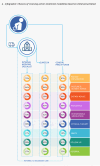Disparities in management of symptomatic osteoporotic vertebral compression fractures: a nationwide multidisciplinary survey
- PMID: 39441383
- PMCID: PMC11499376
- DOI: 10.1007/s11657-024-01454-8
Disparities in management of symptomatic osteoporotic vertebral compression fractures: a nationwide multidisciplinary survey
Abstract
This nationwide multidisciplinary survey found dissatisfaction among physicians with current osteoporotic vertebral compression fracture care, revealing significant disparities in diagnosis, treatment, and follow-up practices. Issues include poor communication and differing guidelines. Improving interdisciplinary collaboration and standardized care strategies is essential for better patient outcomes.
Purpose: This survey aims to assess current preferred care practices for symptomatic osteoporotic vertebral compression fractures (OVCF) in the Netherlands, focusing on guideline adherence, identifying knowledge gaps, and clarifying consensus and collaboration across medical disciplines in OVCF treatment.
Methods: This cross-sectional study was conducted via Qualtrics (Provo, UT) using a self-administered online survey distributed to 238 general practitioners and physicians in orthopedics, traumatology, internal medicine, rheumatology, and geriatrics working at 51 hospitals in the Netherlands. The survey, conducted in Dutch, included 36 multiple-choice and two open questions and was accessible via an anonymous email link or QR code. General practitioners received additional questions specific to their role. Data was anonymized, stored securely, and analyzed using descriptive statistics in Microsoft Excel and SPSS (Version 24). Open-ended responses were coded and categorized. The survey was conducted prior to the publication of the updated Federation of Medical Specialists guidelines in 2024.
Results: Physicians across various disciplines uniformly expressed dissatisfaction with current OVCF care. The survey highlighted significant disparities in diagnosis, treatment, and follow-up practices. A lack of communication between primary and secondary care providers and differing guidelines further complicate OVCF management. These issues point to considerable variation in clinical practice and gaps in interdisciplinary collaboration.
Conclusion: Addressing the identified issues requires fostering interdisciplinary collaboration and creating cohesive care strategies. Ensuring access to diagnostic resources in both primary and secondary care and establishing coordinated care models promises more structured and standardized treatment. These steps are crucial for enhancing patient outcomes in OVCF management.
Keywords: Dissatisfaction; OVCF management; Osteoporosis; Osteoporosis treatment; Osteoporotic vertebral compression fracture; Survey.
© 2024. The Author(s).
Conflict of interest statement
None.
Figures






References
-
- Hernlund E et al (2013) Osteoporosis in the European Union: medical management, epidemiology and economic burden. A report prepared in collaboration with the International Osteoporosis Foundation (IOF) and the European Federation of Pharmaceutical Industry Associations (EFPIA). Arch Osteoporos 8(1):136 - PMC - PubMed
-
- Sattui SE, Saag KG (2014) Fracture mortality: associations with epidemiology and osteoporosis treatment. Nat Rev Endocrinol 10(10):592–602 - PubMed
MeSH terms
LinkOut - more resources
Full Text Sources
Medical

